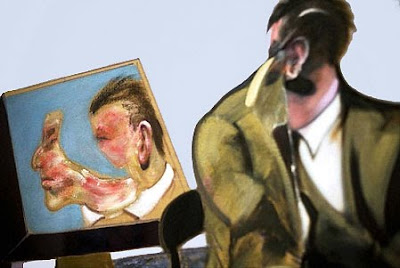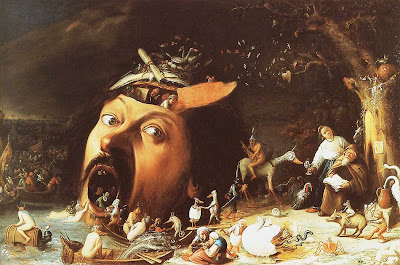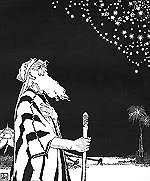An imaginary painting is a fictional picture, one belonging to a fictitious world.
As a fictional painting, the imaginary picture may exist in a fictitious world (real of imagination). But imaginary pictures may also refer to paintings or drawings showing fictitious beings and/or fictitious worlds.
Some imaginary paintings can be found in literature. Indeed, the 64 paintings described by Philostratus in Eikones may be imaginary paintings.
In Ars Poetica, Horace describes an imaginary picture featuring a ridiculous hybrid.
In Interpretazioni veneziane (1984) is stated that the imagery that Pietro Aretino describes at the beginning of the Passion carries conviction, although some commentators suggest he may be describing an imaginary painting by Titian or Tintoretto.[1]
Nicholas Meyer's 1993 novel The Canary Trainer describes a fictional painting by the well-known Impressionist Degas, which happens to show... Sherlock Holmes.
Significantly, an imaginary picture is expected to show something imagined, fabricated, or unreal:
1. An imaginary figure or motif
2. A fictional event
3. Real things in fictional arrangement, as in the case of 18th-century Italian capricci.
Note that an accurately depicted image that looks as real as the object it represents, and can thus deceive the viewer who usually takes it for the very object it represents, as it happens with trompe l'oeil, is a case of hyper-representation or ultra-mimesis. Trompe l'oeil has to do with extreme realism in art. As a general rule, the real tends to oppose imagination.
Yet... imagination takes it all
Special mention in this context deserves The Experts, a 1837 oil painting by French painter Decamps. The picture is a parody of 19th-century Realism and its adherents. Decamps reccurs to realist style. The things he paints look real and convincing. Yet the whole image is a fruit of his imagination, as pressumably no monkey ever acted as an art expert in the French Académie Royale de Peinture et de Sculpture.[2] Moreover, the landscape painting the "experts" examine is a fabrication in its own right. Mocking those who cannot but appreciate the imitation of Nature, Decamp's humorous oil is no doubt a masterpiece of imaginary art too. As Giordano Bruno once put it, the fictitious image entails its own truth.
Notes
1. Passion apparently refers to La passione di Gesù of 1535; Interpretazioni veneziane: Studi di storia dell'arte in onore di Michelangelo Muraro, ed. David Rosand, Venice: Arsenale, 1984.
2. The Experts, also known as The Monkey Connoisseurs, is a satire of the jury of the French Academy of Painting, which had rejected several of Decamps' earlier works on account of their divergence from any known standard (Art and Popular Culture Encyclopedia).
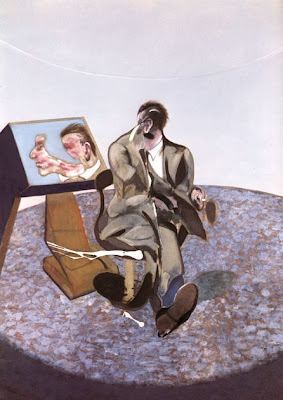 |
| Francis Bacon Portrait of George Dyer in a Mirror 1968 Museo Thyssen-Bornemisza, Madrid |
As a fictional painting, the imaginary picture may exist in a fictitious world (real of imagination). But imaginary pictures may also refer to paintings or drawings showing fictitious beings and/or fictitious worlds.
Some imaginary paintings can be found in literature. Indeed, the 64 paintings described by Philostratus in Eikones may be imaginary paintings.
In Ars Poetica, Horace describes an imaginary picture featuring a ridiculous hybrid.
In Interpretazioni veneziane (1984) is stated that the imagery that Pietro Aretino describes at the beginning of the Passion carries conviction, although some commentators suggest he may be describing an imaginary painting by Titian or Tintoretto.[1]
Nicholas Meyer's 1993 novel The Canary Trainer describes a fictional painting by the well-known Impressionist Degas, which happens to show... Sherlock Holmes.
Significantly, an imaginary picture is expected to show something imagined, fabricated, or unreal:
1. An imaginary figure or motif
| Dragon from a medieval illuminated manuscript |
2. A fictional event
 |
| From time to time... it happens. |
3. Real things in fictional arrangement, as in the case of 18th-century Italian capricci.
 |
| Giovanni Battista Piranesi, The Grotteschi: Capriccio II - The Triumphal Arch, 1747 |
Note that an accurately depicted image that looks as real as the object it represents, and can thus deceive the viewer who usually takes it for the very object it represents, as it happens with trompe l'oeil, is a case of hyper-representation or ultra-mimesis. Trompe l'oeil has to do with extreme realism in art. As a general rule, the real tends to oppose imagination.
 |
| Not imaginary art but rather mimesis. Imitation has nothing to do with the Imaginary. Representation is not Invention. |
Yet... imagination takes it all
 |
| Alexandre-Gabriel Decamps, The Experts, 1837 |
Special mention in this context deserves The Experts, a 1837 oil painting by French painter Decamps. The picture is a parody of 19th-century Realism and its adherents. Decamps reccurs to realist style. The things he paints look real and convincing. Yet the whole image is a fruit of his imagination, as pressumably no monkey ever acted as an art expert in the French Académie Royale de Peinture et de Sculpture.[2] Moreover, the landscape painting the "experts" examine is a fabrication in its own right. Mocking those who cannot but appreciate the imitation of Nature, Decamp's humorous oil is no doubt a masterpiece of imaginary art too. As Giordano Bruno once put it, the fictitious image entails its own truth.
 |
| Gabriel Cornelius von Max, Monkeys as Judges of Art, 1889 Oil on canvas, 85 x 107 cm. Neue Pinakothek, Munich |
Notes
1. Passion apparently refers to La passione di Gesù of 1535; Interpretazioni veneziane: Studi di storia dell'arte in onore di Michelangelo Muraro, ed. David Rosand, Venice: Arsenale, 1984.
2. The Experts, also known as The Monkey Connoisseurs, is a satire of the jury of the French Academy of Painting, which had rejected several of Decamps' earlier works on account of their divergence from any known standard (Art and Popular Culture Encyclopedia).
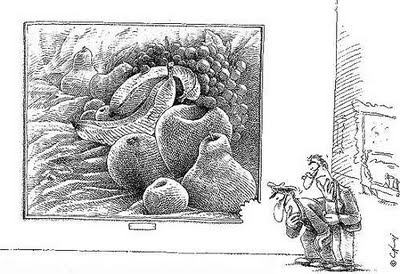 |
| Art by Caloi |
